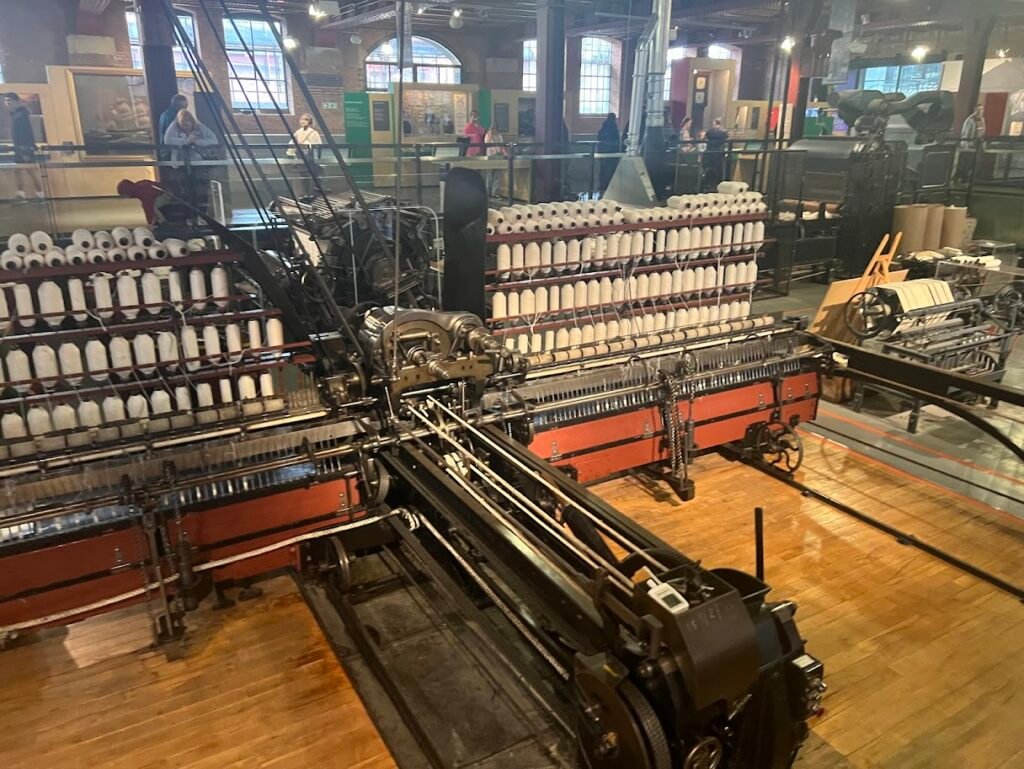Some days stay with you long after you’ve gone home, and my recent visit to the Science and Industry Museum in Manchester was one of those. It took me back to my childhood, when we visited the Museum on a school trip many moons ago. I’m glad to report the museum has undergone some modernisation since then! Here’s my post on my visit to the Manchester Museum of Science and Industry with accessibility in mind.
Nestled in the heart of the city, this museum blends the fascinating story of Manchester’s industrial past with modern science and innovation. It’s not just a museum—it’s an experience that celebrates curiosity, invention, and progress in every form.
The museum is located on Liverpool Road, just a short stroll from Deansgate. It sits proudly on the site of the world’s first passenger railway station, which feels fitting for a museum that tells the story of how industry shaped not just Manchester, but the modern world. As I approached, the beautiful red-brick buildings contrasted against the glass of newer city structures—it felt like stepping into a place where history and modernity shake hands.
Getting There and Parking
Before my visit, I checked out the museum’s accessibility information, and I was genuinely impressed. The Science and Industry Museum is very accessibility-friendly. Disabled parking is available close to the entrance, with clearly marked spaces for Blue Badge holders. We found it easy to park and access the main entrance without any awkward slopes or obstacles.
If you’re travelling by public transport, Deansgate train station and the Deansgate-Castlefield Metrolink stop are both nearby. The route from the station is flat and well-paved, making it manageable for wheelchair users or anyone with limited mobility.
Free Carer Tickets and Entry
Admission to the museum is free, which already makes it a fantastic day out for families or anyone looking for something meaningful to do without spending much. But what I appreciated even more was that carers go free too—no complicated forms, no awkward explanations. It’s a small gesture that makes a huge difference for visitors with disabilities. I went with a friend who uses a wheelchair, and the whole process was smooth and welcoming.
Accessibility Throughout the Museum
Inside, the museum’s accessibility is clearly a priority. All buildings have lifts or ramps, and the staff couldn’t have been more helpful. They offered guidance on accessible routes and even pointed out quieter areas where my friend could take a break. The museum offers free wheelchair and mobility scooter hire, which can be reserved in advance. This is a brilliant feature because the museum covers several buildings and exhibitions, and having mobility support available makes the experience far more comfortable for everyone.
Accessible toilets are available across the site and are clean, spacious, and clearly signposted. There’s also a Changing Places facility for those who need additional equipment or space, which is something not all attractions offer but absolutely should. It really makes the day easier and more enjoyable when you don’t have to worry about accessibility barriers.
The Museum Experience
The museum itself is an incredible mix of history, engineering, and hands-on science. It’s divided into several themed galleries, each exploring a different aspect of how science and industry have shaped the world we live in. What struck me most was how the museum manages to make complex topics feel approachable. You don’t have to be a science buff to be captivated here—everything is designed to spark curiosity.
The Power Hall and Manchester’s Industrial Past
One of my favourite areas was the Power Hall, which celebrates Manchester’s industrial might. This building is currently undergoing a major restoration, but parts of it are open and give a real sense of the noise, energy, and sheer scale of the machinery that once powered the city. The smell of oil, the gleam of metal, and the rhythmic chug of the engines—it’s almost like stepping back into the 19th century. The displays explain how steam power revolutionized not just transport, but everyday life, and it’s fascinating to imagine how different Manchester must have looked back then.
Experiment! Hands-On Science for All Ages
Another highlight was the Experiment! gallery, a space full of interactive exhibits that make science fun and accessible for everyone. It’s great for families, but honestly, I think adults enjoy it just as much as kids. I found myself trying out the sound wave experiments and watching how different materials react to static electricity. Everything is set up at various heights, so children and wheelchair users can reach and enjoy the activities equally. It’s bright, busy, and full of laughter—the kind of learning that happens without feeling like learning.
The Textiles Gallery: Manchester’s Cotton Legacy
You can’t talk about Manchester’s industrial history without mentioning cotton. The Textiles Gallery brings that story to life beautifully. You can see original machinery that once spun and wove the fabrics that earned Manchester its nickname, “Cottonopolis.” What’s incredible is that many of these machines still work. There are live demonstrations where staff show how raw cotton was turned into thread and fabric. The rhythmic clatter of the looms fills the room—it’s hypnotic and humbling to think of the generations of workers who powered these machines.

Science, Technology, and the Future
Beyond history, the museum looks firmly toward the future too. The Revolution Manchester Gallery explores modern-day science, technology, and innovation—from computing to renewable energy. There are displays about Manchester’s role in developing the first stored-program computer and exhibits about future technologies shaping our world. As someone who loves tech but sometimes feels overwhelmed by it, I found the explanations clear and grounded. It’s a reminder of how deeply science is woven into our daily lives, even when we don’t notice it.
Accessible Dining and Relaxing Spaces
After exploring for a few hours, we headed to the museum café, which was a lovely surprise. It’s bright, spacious, and accessible with plenty of room between tables for wheelchairs and mobility scooters. The counter is at a good height, and staff are happy to bring food and drinks to your table if needed. The menu includes vegetarian, vegan, and gluten-free options, and the prices are reasonable. There’s also a picnic area outside for those who prefer to bring their own food. We chose to sit near the windows overlooking the courtyard—it’s a great spot for people-watching and soaking up the atmosphere.
Gift Shop and Final Impressions
Before leaving, I couldn’t resist a visit to the gift shop. It’s full of quirky science-themed gifts, books, and toys. What stood out again was how accessible the layout was—wide aisles, low shelves, and staff ready to help. I picked up a small magnet featuring one of the old engines as a memento of the day.
Walking back to the car, I felt genuinely uplifted. The Science and Industry Museum isn’t just about machines and experiments; it’s about people—the inventors, workers, and dreamers who changed the world. It’s a place that manages to be both educational and deeply human. Whether you’re fascinated by engines, curious about computing, or just looking for an enjoyable day out in Manchester, it’s well worth a visit.
And if you’re someone who relies on accessibility support, you can visit knowing you’ll be looked after. From disabled parking and free carer tickets to accessible toilets and mobility hire, every detail has been thoughtfully considered. That kind of inclusivity transforms a good day out into a great one.
As we left, I looked back at the museum’s old railway buildings glowing softly in the afternoon light. It felt symbolic—a city that once powered the industrial age now powering curiosity and learning for the next generation. And honestly, that’s a story worth experiencing firsthand.
If you’d like another idea for an accessible day out in Manchester, see my post on Fletcher Moss Park Accessibility.
Discover more from The Blue Badge Blog
Subscribe to get the latest posts sent to your email.




Leave a Reply